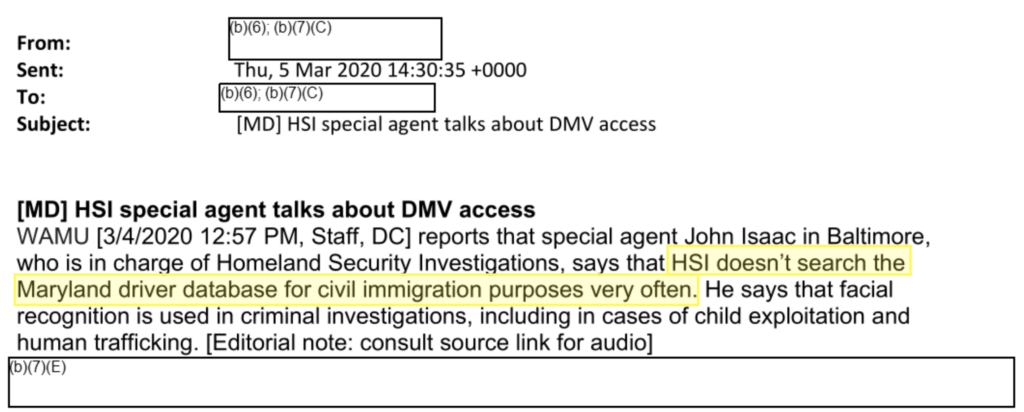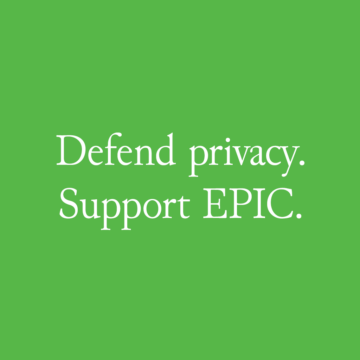Is ICE Using Facial Recognition to Track People Who Allegedly Threaten Their Agents?
March 17, 2022 |

Facial recognition is a powerful surveillance technology that can easily be implemented on a mass scale because of the abundance of pictures and videos online and the ubiquitousness of cameras in our society. This ease of implementation is part of the reason facial recognition technology is so dangerous—making misuse an ever-present likelihood.
Immigration and Customs Enforcement (ICE) is no stranger to the misuse of technology, particular facial recognition technology where they have leveraged state DMV databases to run facial recognition searches and have contracted with Clearview AI—a controversial facial recognition platform that has scoured the internet for photos to create a facial recognition database of billions of images. But has ICE used the power of facial recognition technology to track people who, according to the agency, have threatened their agents?
Documents obtained by EPIC through a Freedom of Information Act (FOIA) lawsuit suggest they might have. EPIC obtained the following excerpt from an email:

The subject of the email is pretty straightforward about what ICE wants to do with facial recognition, “ICE wants to use facial recognition to track people threatening its agents online.” If ICE ever used facial recognition in this way, it would be a serious abuse of the technology. ICE does not get to just track people that the agency feels threatened by. If the threat is serious, there are other means to address the issue.
This email raises several questions the most pressing of which is whether ICE ever did use facial recognition in this way. The email is between privacy officials within DHS ICE, so this begs the question of how they handled this desire by ICE to use facial recognition to track people who apparently threatened ICE agents. The privacy officials at DHS should release more information on this and be completely transparent on how this issue was handled and whether ICE ever used facial recognition this way.
Unfortunately, it’s not far fetched to think ICE not only used facial recognition technology this way but did so before privacy officials at DHS ever formally reviewed such a use. In fact, the documents obtained by EPIC clearly indicate that ICE was using Clearview before it was assessed by privacy officials. An email obtained by EPIC shows DHS asking to be briefed about the use of Clearview well after ICE had already started using it.

This is not how things are suppose to work. Section 208 of the E-Government Act of 2002 requires federal agencies to complete, review, and publish a privacy impact assessment (PIA) before initiating the collection of personal data or procuring information technology. According to Office of Management and Budget regulations, agencies are suppose to “draft a PIA with sufficient clarity and specificity to demonstrate that the agency fully considered privacy and incorporated appropriate privacy protections from the earliest stages of the agency activity and throughout the information life cycle.” All too often the privacy assessments are happening after the fact to add some minimal protections and justify the use of the technology as opposed to a full consideration of the privacy implications. The PIA requirements in the E-Government Act leaves a lot to be desired, but agencies should at least conduct the assessments and publish them before using a new system as required.
Another example of the misuse of facial recognition technology found in the documents EPIC obtained is an email indicating that ICE’s Homeland Security Investigations not only runs facial recognition searches on the Maryland DMV Driver’s License photo database but does so for mere “civil immigration purposes.”

This is an example of mission creep where an agency justifies invasive surveillance technology by claiming it is necessary to address serious crimes involving children and human trafficking and then expands the mission and the use of the surveillance technology to things like civil immigration issues.
ICE’s use of facial recognition is problematic. The lack of transparency and the fact that DHS Privacy is assessing these uses after the fact if at all only exacerbates the issue. The public deserves a full accounting of how ICE (and DHS as a whole) is using facial recognition technology, how it has used facial recognition in the past, and how the agency plans to use facial recognition in the future. And the public deserves to have their say because facial recognition is a powerful technology that implicates our First Amendment protected rights and our democracy. Its use should not be taken lightly, and whether we use it at all and for what purposes is a legitimate question.

Support Our Work
EPIC's work is funded by the support of individuals like you, who allow us to continue to protect privacy, open government, and democratic values in the information age.
Donate